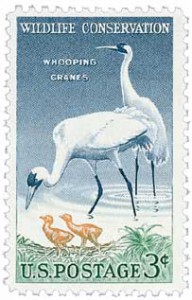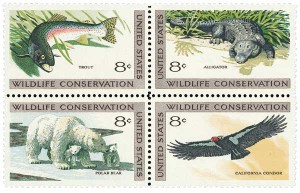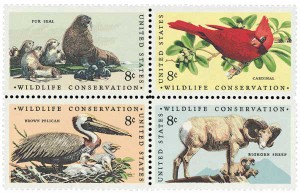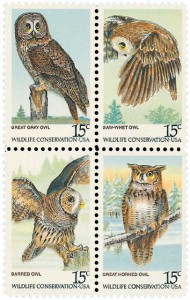Wildlife Conservation Series
Over a period of 22 years, the USPS issued stamps devoted to educating the public about the need to preserve our natural resources.

1956 Wild Turkey
U.S. #1077 was issued to emphasize the importance of wildlife conservation in America. It was the first of three stamps with a similar theme; each one showing a different species. This stamp showcases wild turkeys, the largest and fastest of the game birds. It was issued at the convention of the Wisconsin Federation of Stamp Clubs, in Fond du Lac, Wisconsin.

1956 Pronghorn Antelope
Before the arrival of European settlers, the pronghorn population was an estimated 25 million. By 1920, that number had fallen to about 17,000. Conservation efforts have helped the pronghorn antelope increase to approximately half a million today.

1956 King Salmon
Great efforts have been made to preserve salmon populations and the environment they need to survive. Pollution has been reduced. Fish ladders allow the fish to cross dams and other man-made obstacles. Improved hatcheries produce thousands of healthy salmon to restock rivers and lakes.

1957 Whooping Crane
Early American explorers reported whooping cranes in 35 U.S. states, with numbers now estimated between 700-1,400. By 1941, only 21 whooping cranes were alive in the United States. One migrating flock was known to exist, as it traveled between Canada and Texas. From these 15 birds (the other six were non-migrating residents of Louisiana), the species has started to rebuild its numbers.

1971 Wildlife Conservation
This block of four stamps was issued to raise awareness of the plight of endangered species. The polar bear, the California Condor (one of the rarest birds in the world) and the alligator have all been threatened with extinction. Increased water pollution has also put several species of trout in jeopardy.

1972 Wildlife Conservation
The need for wildlife conservation is stressed with this block of four. While the Alaska Fur Seal, the Cardinal, and the Brown Pelican are not necessarily endangered, in the mid-1970s, there were fewer than 20,000 bighorned sheep.

1978 American Owls


The denomination of the Polar Bear stamp?
U.S. #1429 has a denomination of 8-cents. Did you know you can click on the images in these articles to learn more about the stamps?
https://www.mysticstamp.com/Products/United-States/1429/USA/
Happy Collecting!